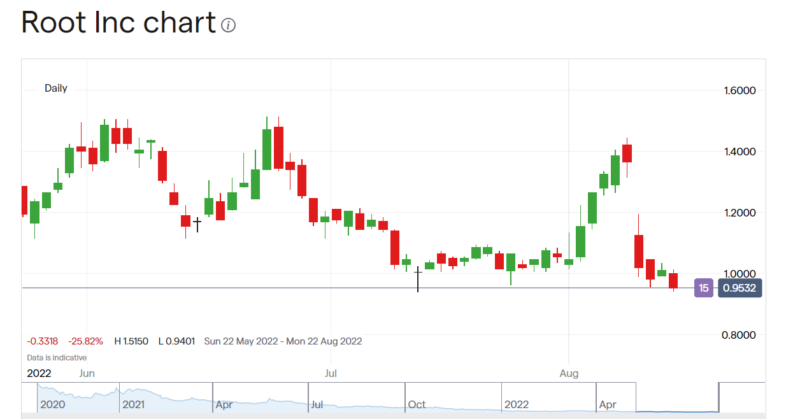Key points:
- Root's stock price is up 1,480% premarket
- ROOT's stock value is down 25% in 24 hours
- There's a reason for that divergence in values
Root Inc (NASDAQ: ROOT) stock is listed on the ticker as being up 1,480% premarket. But the correct reading of the ROOT stock price is that it's down 18% or so. Which is, we should be able to agree, a very different outcome. This is also after a near 6% fall yesterday (yesterday trading day, so Friday), so we're looking at a close to 25% loss in the last 24 trading hours. The difference in these numbers is whether we use nominal or real values. The real value of Root Inc as a whole, the market capitalisation, is down that near 25%. The value of any individual stockholding in ROOT stock is down that near 25%. The only thing that's up that 1,480% is the nominal value of each piece of stock, each share.
As to what Root actually does it's an insurer. It's trying to use the new online world to sell direct to consumer the insurances that people simply must have – auto, homeowners, renters insurance and so on. This sounds like a reasonable enough idea, this isn't like selling life insurance to people – folk really do need and almost always do buy these insurances. So, if online can be a new and cheaper way of doing that selling then we might indeed see some decent margins coming off that.
The problem seems to be that there aren't decent margins coming off it. The latest, Q2 figures, showed a 21% fall in gross written premiums so something's amiss with the idea. Maybe there are enough other people out there doing the same that the competition is thought. Most likely, as we can test by doing a Google search ourselves, the legacy insurance companies have also moved online – it's not an exclusive offering from Root that is.

Also Read: What Would Warren Buffett Invest In Now
As to how the ROOT stock price can be up 1,480% in nominal terms and yet down 18% today, 25% in 24 hours in real terms, that's because there's been a reverse stock split – a consolidation to Brits. The initial idea here is nothing but fashion – it's just felt that the “right range” for a stock price in New York is $10 to $100. Anything that's below $1 is – and is by definition of course – down in that appalling world of penny stocks. That's just fashion and we can prove that because the same range for London is £1 to £10.
However, if an American stock gets into that penny range, below a $, then it can lose the NASDAQ quote. That means relegation to the OTC markets with less liquidity and greater difficulties in raising capital. So, if that has happened why not simply reduce the number of shares in issue? Exactly what Root has done. Everyone who owned 18 pieces of stock on Friday now owns one. That should mean an 1800% price rise. That the price rise is only 1,480% means that the real price has fallen by about that 18%. Add the near 6% from Friday and we get to the 25% price fall over the 24 trading hours.
Of course, reverse stock splits aren't supposed to work out this way, they're supposed to add value, but plans of mice and men and all that.




